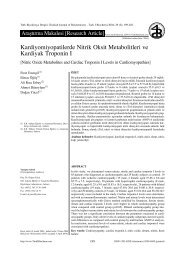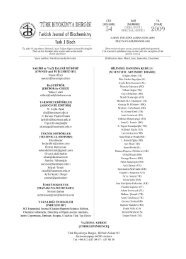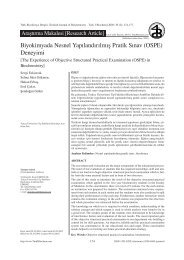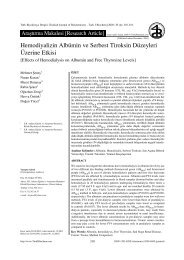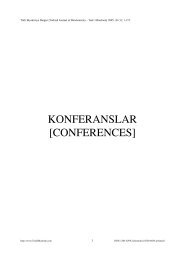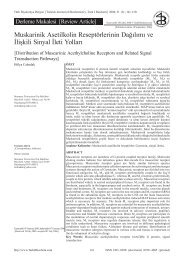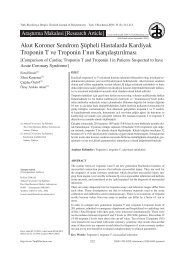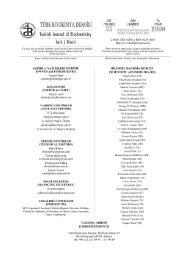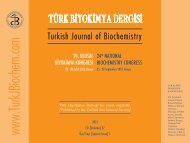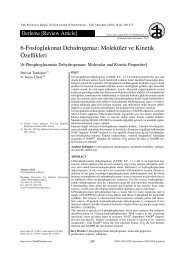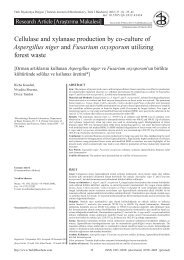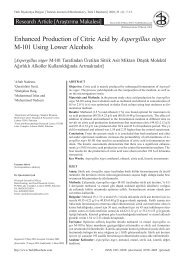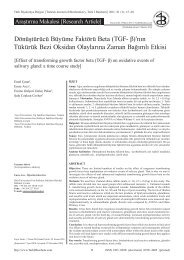23. Ulusal Biyokimya Kongresi Ãzel Sayısı - Türk Biyokimya Dergisi
23. Ulusal Biyokimya Kongresi Ãzel Sayısı - Türk Biyokimya Dergisi
23. Ulusal Biyokimya Kongresi Ãzel Sayısı - Türk Biyokimya Dergisi
You also want an ePaper? Increase the reach of your titles
YUMPU automatically turns print PDFs into web optimized ePapers that Google loves.
XXIII. ULUSAL B‹YOK‹MYA KONGRES‹<br />
29 Kasım - 2 Aralık 2011<br />
Hilton Hotel - Adana<br />
<strong>23.</strong> <strong>Ulusal</strong> <strong>Biyokimya</strong> <strong>Kongresi</strong>, Adana [23 rd National Biochemistry Congress, Adana / TURKEY]<br />
İÇİNDEKİLER<br />
DAVETLİ KONUŞMACI ÖZETLERİ<br />
HBA1C ÖLÇÜM SONUÇLARININ VE RAPORLANMASININ<br />
STANDARDİZASYONUNDA YENİ GELİŞMELER<br />
Diler ASLAN<br />
Pamukkale Üniversitesi, Tıp Fakültesi, Tıbbi <strong>Biyokimya</strong> Anabilim Dalı, Denizli.<br />
HbA1c düzeyinin uzun dönem glisemik kontrolde altın standard ve diyabetin<br />
mikrovasküler komplikasyonlarının öngördürücüsü olduğu bilimsel olarak<br />
kanıtlanmıştır. Bu bağlamda test sonuçlarının standardizasyonu için Uluslararası Klinik<br />
Kimya ve Laboratuvar Tıbbı Federasyonu (IFCC) referans sistemi yapılandırılmıştır.<br />
Kit üreticileri ABD’de NGSP/DCCT’ye göre kalibre ederek FDA onayı alırlarken,<br />
AB’de CE etiketi için IFCC’ye göre kalibrasyon gereklidir ve test sonuçları, sırasıyla,<br />
yüzde (%) ve (mmol/mol) olarak raporlanmaktadır. SI birimi mmol/mol’dür. Birimler<br />
arasında IFCC-DCCT (Diabetes Control and Complications Trial) çevirme denklemi<br />
de oluşturulmuştur. İki birimin kullanılması konusu tartışılmıştır. HbA1c değerlerinin<br />
son 2-3 aylık glukoz ortalamasına çevrilerek raporlanması da önerilmiştir. Dünyadaki<br />
diyabet (ADA, American Diabetes Association; EASD, Eurpean Association of<br />
Society for Diabetes; IDF, International Diabetes Federation; ISPAD, International<br />
Society for Pediatry and Adaloscent Diabetes) ve laboratuvar tıbbı ile ilişkili dernekler<br />
(IFCC, International Federation of Clinical Chamistry) 2010 yılında bir bildirge<br />
yayımlamışlardır. Önerilerden bazıları şunlardır: -HbA1c test sonuçları raporlanması da<br />
dahil dünya genelinde standardize edilmelidir; -Ölçüm kitleri IFCC referans sistemine<br />
göre izlenebilir olmalıdır; -Klinik laboratuvarlar sonuçları bir süre hem (%-tek ondalık)<br />
hem de (mmol/mol-ondalıksız) olarak birlikte raporlamalıdır; -Bu durum 2011 yılı<br />
içinde ülkeler boyutunda yapılacak çalışmalarla tüm dünyada yaygınlaştırılmalıdır.<br />
Çeşitli ülkelerde, bilimciler, meslek uzmanları, klinisyenler ve kit üreticileri birlikte<br />
karar vererek uzlaşmaktalar ve raporlama dahil standardizasyon ve harmonizasyon<br />
için çalışmaları yürütmektedirler. Ancak ülkemizde çok çeşitli nedenlerden dolayı<br />
laboratuvar sektöründe uzlaşmak zorlayıcı bir unsurdur. Çoğunlukla, öneri vermekten<br />
çok söylenenin yapılması eğilimi bulunmaktadır. Bu alandaki gelişmelerin özetlendiği<br />
konuşmamın temel amacı bu önerilerin Türkiye’de uygulanmasının etkin diyabet<br />
bakımı açısından önemini ve klinik laboratuvar direktörlerinin sorumluluklarından<br />
birisi olduğunu vurgulamaktır.<br />
Anahtar Kelimeler: HbA1c standardizasyon SI Birimleri uzlaşı “ortalama plazma<br />
glikozu”<br />
RECENT DEVELOPMENTS IN THE STANDARDIZATON OF HBA1C<br />
MEASUREMENTS AND RESULTS REPORTING<br />
Diler ASLAN<br />
Department of Medical Biochemistry, School of Medicine, Pamukkale<br />
University, Denizli.<br />
The HbA1c values are used as the gold standard for long-term follow-up of glycemic<br />
control, and for predicting of microvascular complications of diabetes. In this respect,<br />
the IFCC Reference System (IFCC-RefS) for HbA1c measurements was established.<br />
Kit manufacturers in the US and the EU have to get the FDA approval and CE Label<br />
by calibrating their kits according to the NGSP/DCCT designated comparison method<br />
and IFCC-RefS, respectively. The IFCC-DCCT master equation for conversion of<br />
the units was established. But, the arguments for reporting the HbA1c results had<br />
been continued, and the reporting the HbA1c-derived average glucose values instead<br />
of HbA1c values was also suggested. After several meetings between the societies<br />
of diabetes (the ADA, EASD, IDF, ISPAD) and laboratory medicine (IFCC), the<br />
2010 consensus statement was approved. Some recommendations in the statement<br />
are: -HbA1c test results and reporting should be standardized worldwide. -The kits<br />
are to be traceable according to the IFCC-RefS, and the results should be reported by<br />
clinical laboratories in both SI (mmol/mol-no decimals) and derived NGSP units (%-<br />
one decimal). -The consensus recommendations should be applied through 2011 at the<br />
national level. In several countries, the scientists, laboratory specialists, clinicians and<br />
kit manufacturers are applying these recommendations by taking decisions together<br />
at the national level. However, the establishment of such consensus statements in<br />
our country is a challenging issue because of several reasons. The main objective<br />
of my talk is to emphasize the importance of the nationwide application of these<br />
recommendations for efficient diabetes care, and also that this applications are one of<br />
the responsibilities of the clinical laboratory directors.<br />
CONTENTS<br />
ABSTRACTS OF INVITED LECTURES<br />
Turk J Biochem, 2011; 36 (S2)<br />
http://www.TurkJBiochem.com



